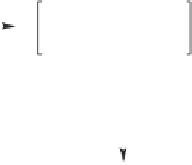Chemistry Reference
In-Depth Information
This chapter deals mainly with asymmetric PKRs based on these three approaches. A
fourth possibility for rendering the PKR enantioselective consists o using the chiral auxiliary
as a ligand in the metal complex either in a stoichiometric or in a catalytic fashion (Scheme
5.8),
12, 13
and is discussed
in extenso
in Chapter 6. Finally, we will comment on the use of
chiral reagents for obtaining nonracemic PK adducts.
O
R
1
Co
2
(Xc)(CO)
n
+
*
R
1
D
inter
R
2
*
R
2
O
R
Co
2
(Xc)(CO)
n
*
R
D
intra
*
Scheme 5.8
5.2 Asymmetric Intramolecular PKRs with the Aid of Chiral Auxiliaries
5.2.1 Chiral Alkoxyacetylenes
The first ideas concerning the use of chiral alcohols as stereochemical controllers in the
PKR crystallized during the fall of 1986 in the laboratory of Prof. Andrew E. Greene
in Grenoble, where, in the context of a research program on chiral auxiliary-mediated
asymmetric [2
2] cycloadditions, the author of this chapter had developed a convenient
synthesis of chiral alkoxyacetylenes (Scheme 5.9).
14, 15
+
Cl
Cl
(1 equiv)
KH (2 equiv)
n
-BuLi (2.5 equiv)
Cl
H
R*OH
R*O
Li
THF, rt
-50 °C, 1 h
-70 °C to -40 °C, 0.5 h
RI, HMPA;
or H
2
O
R*OH = chiral secondary alcohol or phenol
R = Me,
n
-alkyl, allyl
66-88% yield
R*O
R(H)
Scheme 5.9
This research set the stage for the first chiral auxiliary-mediated asymmetric intramolecu-
lar PKR, disclosed in 1990 (Table 5.1).
16
Best results (52% de) were obtained for compound









































